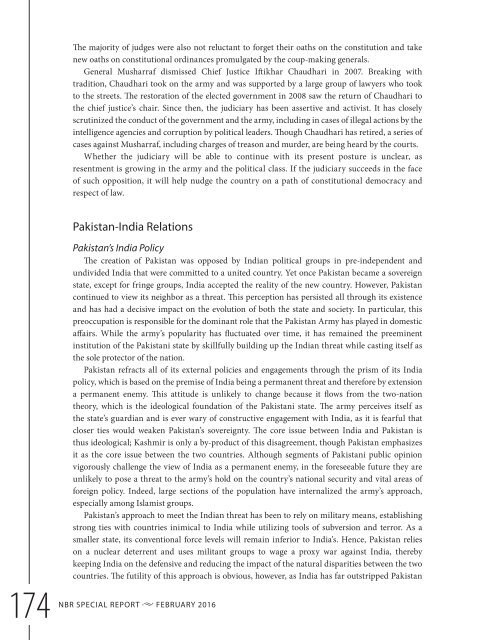pakistan’s
SR55_Mapping_Pakistan_February2016
SR55_Mapping_Pakistan_February2016
Create successful ePaper yourself
Turn your PDF publications into a flip-book with our unique Google optimized e-Paper software.
The majority of judges were also not reluctant to forget their oaths on the constitution and take<br />
new oaths on constitutional ordinances promulgated by the coup-making generals.<br />
General Musharraf dismissed Chief Justice Itikhar Chaudhari in 2007. Breaking with<br />
tradition, Chaudhari took on the army and was supported by a large group of lawyers who took<br />
to the streets. The restoration of the elected government in 2008 saw the return of Chaudhari to<br />
the chief justice’s chair. Since then, the judiciary has been assertive and activist. It has closely<br />
scrutinized the conduct of the government and the army, including in cases of illegal actions by the<br />
intelligence agencies and corruption by political leaders. Though Chaudhari has retired, a series of<br />
cases against Musharraf, including charges of treason and murder, are being heard by the courts.<br />
Whether the judiciary will be able to continue with its present posture is unclear, as<br />
resentment is growing in the army and the political class. If the judiciary succeeds in the face<br />
of such opposition, it will help nudge the country on a path of constitutional democracy and<br />
respect of law.<br />
Pakistan-India Relations<br />
174<br />
NBR<br />
Pakistan’s India Policy<br />
The creation of Pakistan was opposed by Indian political groups in pre-independent and<br />
undivided India that were committed to a united country. Yet once Pakistan became a sovereign<br />
state, except for fringe groups, India accepted the reality of the new country. However, Pakistan<br />
continued to view its neighbor as a threat. This perception has persisted all through its existence<br />
and has had a decisive impact on the evolution of both the state and society. In particular, this<br />
preoccupation is responsible for the dominant role that the Pakistan Army has played in domestic<br />
affairs. While the army’s popularity has fluctuated over time, it has remained the preeminent<br />
institution of the Pakistani state by skillfully building up the Indian threat while casting itself as<br />
the sole protector of the nation.<br />
Pakistan refracts all of its external policies and engagements through the prism of its India<br />
policy, which is based on the premise of India being a permanent threat and therefore by extension<br />
a permanent enemy. This attitude is unlikely to change because it flows from the two-nation<br />
theory, which is the ideological foundation of the Pakistani state. The army perceives itself as<br />
the state’s guardian and is ever wary of constructive engagement with India, as it is fearful that<br />
closer ties would weaken Pakistan’s sovereignty. The core issue between India and Pakistan is<br />
thus ideological; Kashmir is only a by-product of this disagreement, though Pakistan emphasizes<br />
it as the core issue between the two countries. Although segments of Pakistani public opinion<br />
vigorously challenge the view of India as a permanent enemy, in the foreseeable future they are<br />
unlikely to pose a threat to the army’s hold on the country’s national security and vital areas of<br />
foreign policy. Indeed, large sections of the population have internalized the army’s approach,<br />
especially among Islamist groups.<br />
Pakistan’s approach to meet the Indian threat has been to rely on military means, establishing<br />
strong ties with countries inimical to India while utilizing tools of subversion and terror. As a<br />
smaller state, its conventional force levels will remain inferior to India’s. Hence, Pakistan relies<br />
on a nuclear deterrent and uses militant groups to wage a proxy war against India, thereby<br />
keeping India on the defensive and reducing the impact of the natural disparities between the two<br />
countries. The futility of this approach is obvious, however, as India has far outstripped Pakistan<br />
SPECIAL REPORT u FEBRUARY 2016



